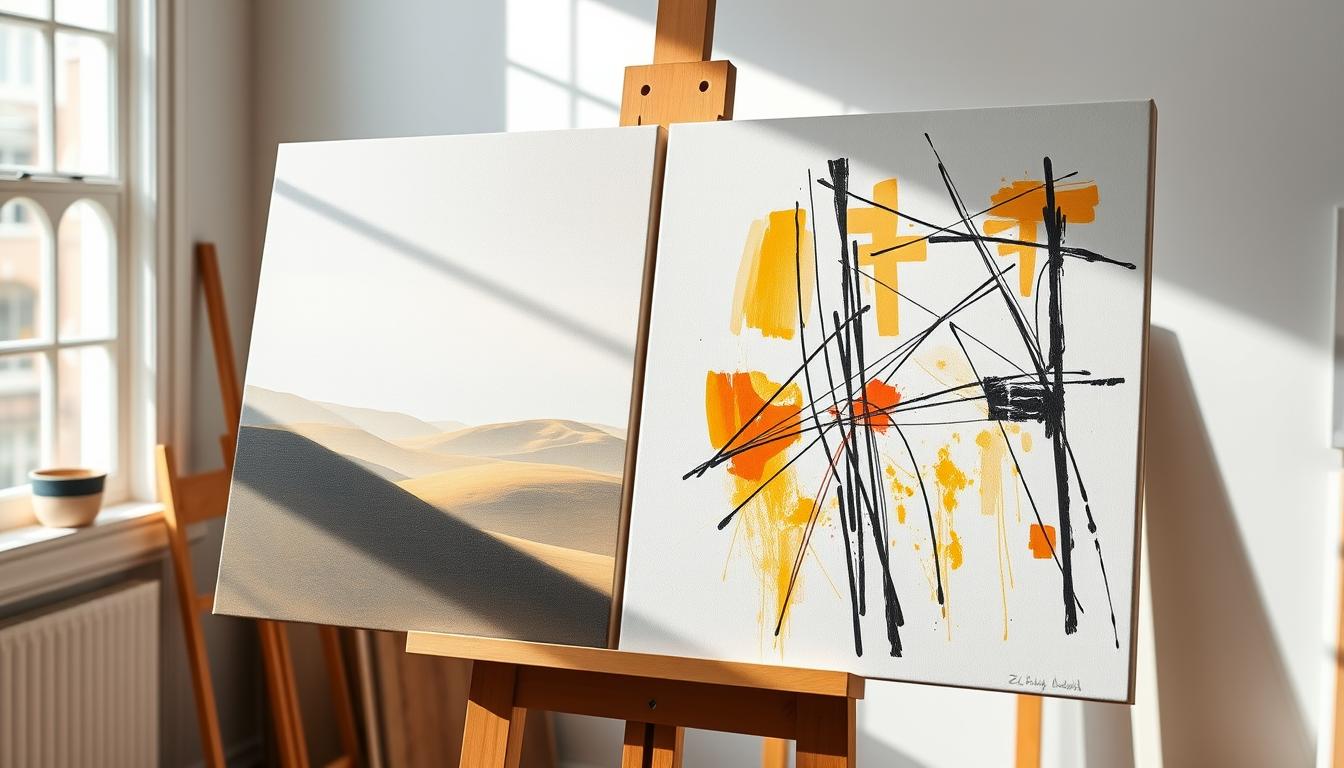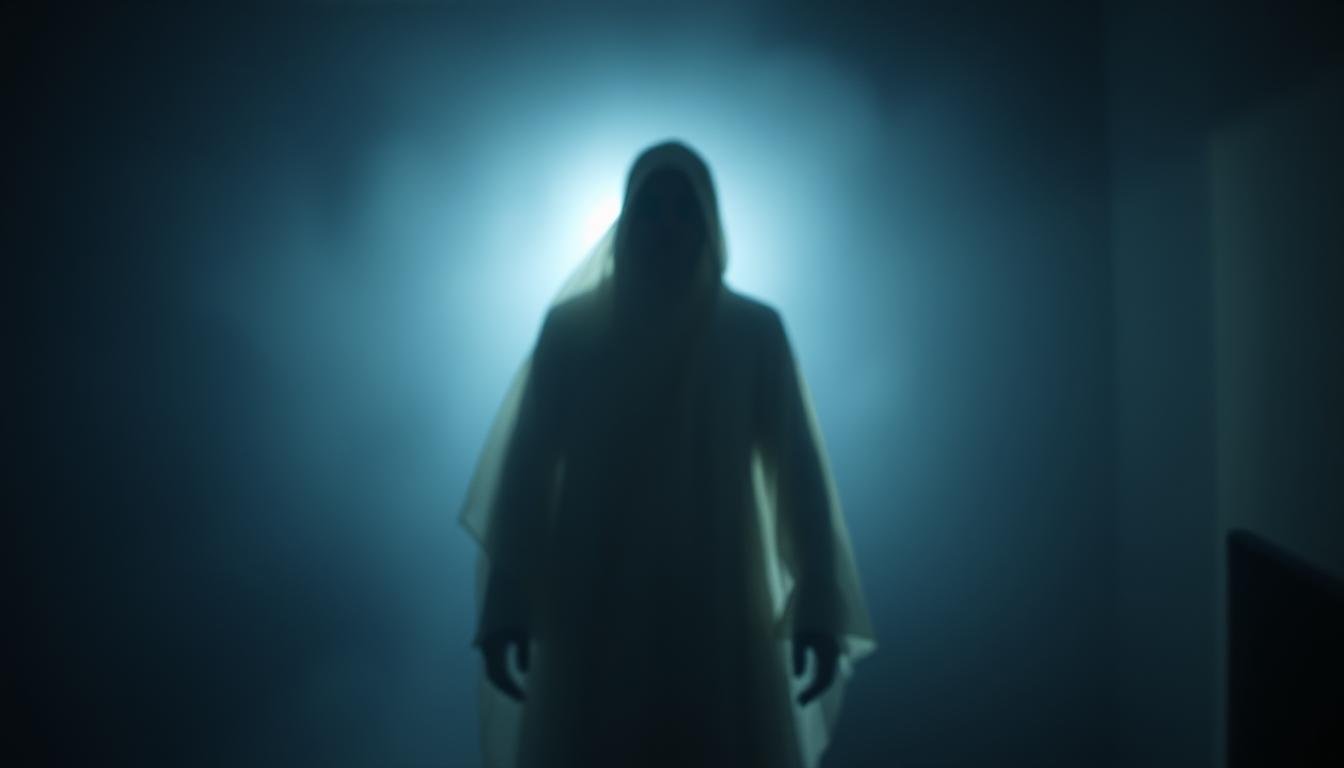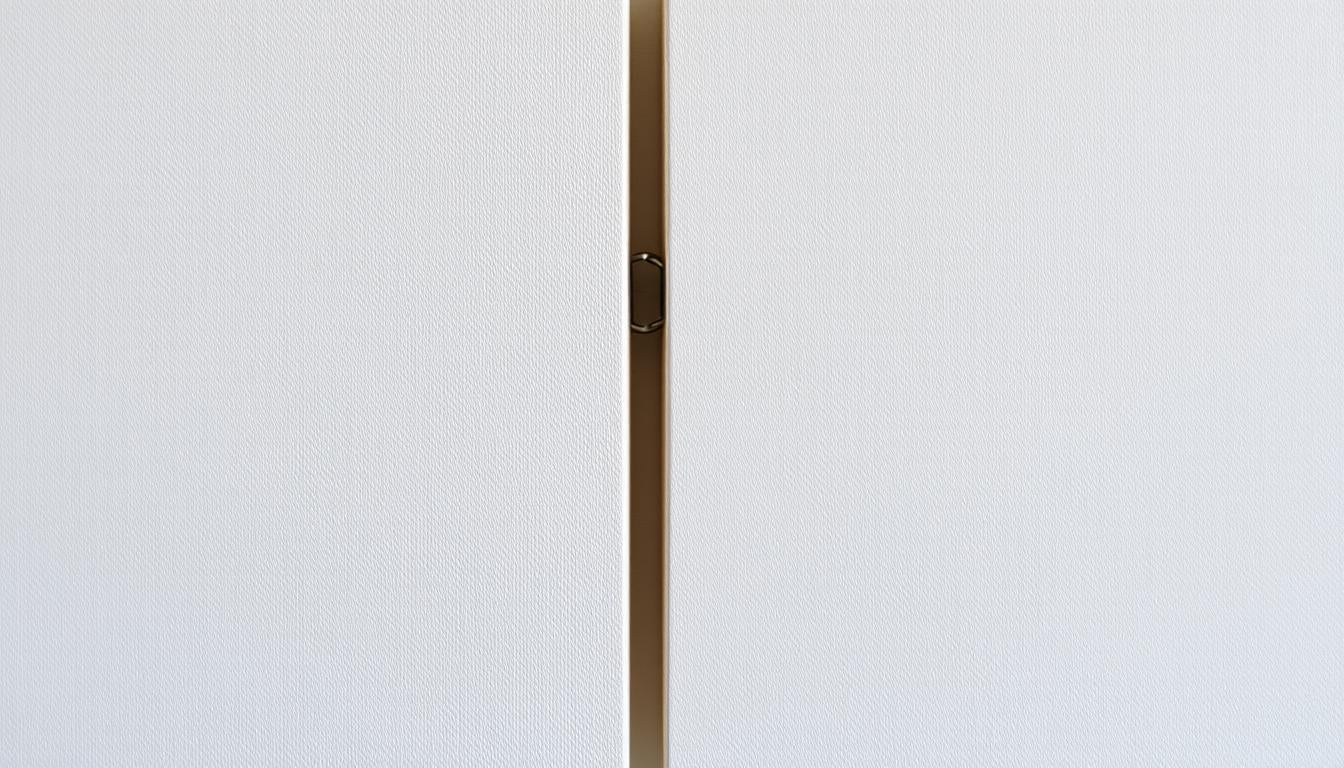The short answer: that format is called a diptych.
Diptych (pronounced “DIP-tick”) names an artwork made of two panels that join to form one image. This setup goes back to ancient folded tablets and later served as portable devotional panels in medieval and Byzantine art.
You’ll find diptychs in painting, photography, and mixed media when one visual motif flows from one canvas to the next. Modern pieces often hang side-by-side without hinges but still read as a single composition.
For a quick glossary-style definition and historical notes, see this brief entry on diptych. Knowing the term helps you name, display, and discuss these paired panels confidently in galleries or at home.

Key Takeaways
- A diptych is the standard name for one image spread across two panels.
- Pronounced “DIP-tick,” it signals unity, not just side-by-side works.
- The term has roots in ancient and medieval double-leaf formats.
- Diptychs appear across media, from oil on canvas to contemporary photography.
- Modern versions often hang as two aligned supports without hinges.
What is a two-canvas painting called?
Artists often split one visual idea across two supports to make a single work. The correct name for that format is diptych. A diptych links two panels so the whole reads as one coherent image.
A true diptych shows composition that carries across the gap: lines, color, or forms continue from one side to the other. If two separate paintings are merely hung together but do not connect visually, they are not diptychs.
How to recognize and say it
Pronounce it “DIP-tick” (/ˈdɪptɪk/). The term comes from Greek and Latin words for “double-folded,” nodding to hinged panels of the past.
- Diptych = one artwork split across two canvases or panels.
- Hinges are optional today; many diptychs are separate supports installed side-by-side.
- Photographers also use diptychs by pairing or splitting a single photograph into two frames.
Etymology and history of the diptych in art
The word traces to Latin diptycha and Greek díptycha/díptychos, meaning "double-folded." It first named hinged writing tablets with recessed wax. Scribes could scratch notes and then smooth the surface for reuse.

In Late Antiquity carved ivory consular diptychs marked civic honors. These prestige objects show how the format served ceremonial roles and high-status pieces.
From tablets to portable devotional panels
Byzantine and Medieval makers turned the form into small, portable panels for private devotion. Hinges protected painted faces during travel, tying the name to the object's physical design.
Renaissance onward: portraits, icons, evolving formats
Early Netherlandish artists like Jan van Eyck and Hans Memling often paired donor portraits with a Madonna and Child across facing supports. Over the centuries the format shifted from sacred icons to secular portrait pairs and narrative scenes.
- Origins: two-fold tablets for writing and erasing.
- Ceremony: ivory diptychs marked appointments in Late Antiquity.
- Devotion: hinged panels kept paintings safe for travel.
- Evolution: from icons and altarpieces to modern mixed-media pieces.
Diptychs today: media, canvases, and how artists use the format
Contemporary artists use paired panels to push ideas across different visual channels. In today’s gallery scene, diptychs appear in painting, photography, digital files, and mixed media. Many creators exploit contrast—color vs. monotone, detail vs. abstraction—while keeping a single concept across both parts.

Across media
Diptychs now span traditional and new media. A single photograph can be divided into two prints. Or artists may pair complementary shots that complete one idea. Mixed-media pieces combine paint, collage, and digital layers for texture and narrative.
Display and framing basics for two canvases or frames at home
Treat the two parts as one composition. Keep the gap small and consistent so lines and color can read across the seam.
- Measure and level carefully; small misalignment breaks flow.
- Choose slimmer profiles when framing to reduce visual barriers.
- Metal frames help with thicker boards and depths up to about 1/4".
- Center the midpoint of the whole diptych over furniture for balanced display.
Practical tip: If the work was made unframed, a gallery wrap or floater keeps the focus on the continuous image. For more framing ideas and technical notes, learn more about diptychs.
Famous diptych examples and related terms
Several landmark works show how two joined supports can stage contrast, narrative, or ritual across a narrow seam.
Andy Warhol’s Marilyn Diptych (1962) is a classic modern example. One half bursts with color while the other fades in black-and-white. The pairing comments on fame, media saturation, and mortality. The piece belongs to Tate and shaped pop art dialogues.
The medieval Wilton Diptych (c.1395–1399) sits at the National Gallery, London. Two hinged boards show King Richard II opposite the Virgin and Child with angels. Its small scale and portability speak to private devotion and courtly ritual.
Related multi-panel formats
Renaissance paired portraits often place sitters on facing panels across a shared landscape. Piero della Francesca’s diptych of Federico and Battista is one such case.
- Triptych: three panels, common for altarpieces and narrative sequencing.
- Polyptych: any multi-panel arrangement beyond three sections.
These examples show how diptychs let artists contrast color, portraiture, and time across two panels. For more examples and analysis, see this closer look on diptych and triptych works.
Conclusion
Final takeaway: Seen in galleries and private collections, the paired-panel setup remains a compact, powerful format. A diptych joins two panels so they read as one work across time and media.
Practical tip: For home display, align the canvases precisely and choose slim frames to keep the visual flow. Proper spacing makes the seam act like a deliberate pause, not a break.
Diptychs and related triptych pieces let an artist set contrast, repeat themes, or split narrative across two parts. Today these forms appear in painting, photography, and mixed media and still reward careful viewing.
FAQ
What does the term diptych mean in art?
A diptych refers to two panels or canvases that form one coherent image or related pair. Artists arrange the two pieces side by side so they read as a single work or as complementary halves.
How can you tell a true diptych from two separate paintings?
A true diptych shares composition, subject, or continuous imagery across both panels. The join, alignment, or framing often makes the relationship clear. Two separate paintings may hang together but lack the deliberate visual link that defines a diptych.
How is diptych pronounced and what is its basic meaning?
Pronounced "DIP-tik," the word describes a paired panel format used to present a unified narrative or theme across two pieces.
Where does the word diptych come from?
The term comes from Greek roots meaning "two-fold" and passed into Latin. It originally described hinged tablets used for writing and later applied to two-part painted panels.
How were diptychs used in Byzantine and Medieval art?
Artists created portable devotional panels for private worship and liturgical use. These works often featured saints or religious scenes and sometimes included gold leaf and detailed iconography.
How did the diptych evolve from the Renaissance to modern art?
Painters expanded subject matter to include portraits, narrative scenes, and experimental layouts. In contemporary practice, the format appears in photography, mixed media, and large-scale installations.
What media do contemporary artists use for diptychs?
Creators work across oil and acrylic on canvas, photographic prints, digital panels, collage, and mixed media. The format adapts well to both traditional and experimental techniques.
How should two canvases be displayed or framed at home?
Align the tops or centers for visual harmony and leave a small, consistent gap between panels. Choose frames or mounting that reinforce the connection—floating frames, continuous stretcher bars, or a single wide frame work well.
What are famous diptych examples to study?
Andy Warhol’s Marilyn Diptych is a landmark in pop art for its repetition and commentary on mass media. The medieval Wilton Diptych is notable for royal portraiture and devotional imagery.
How do diptychs differ from triptychs and polyptychs?
A triptych uses three panels; polyptychs use multiple panels beyond three. All share the idea of linked images, but the number of panels changes composition, rhythm, and narrative possibilities.
Can photographs and digital images be diptychs?
Yes. Photographers and digital artists create diptychs by pairing two related images to contrast, complete, or extend a visual idea. The same display principles—alignment and spacing—apply.
Are diptychs still popular with contemporary artists?
Absolutely. Many painters, photographers, and mixed-media artists favor the format for storytelling, contrast, and visual dialogue between paired panels.




Leave a comment
This site is protected by hCaptcha and the hCaptcha Privacy Policy and Terms of Service apply.